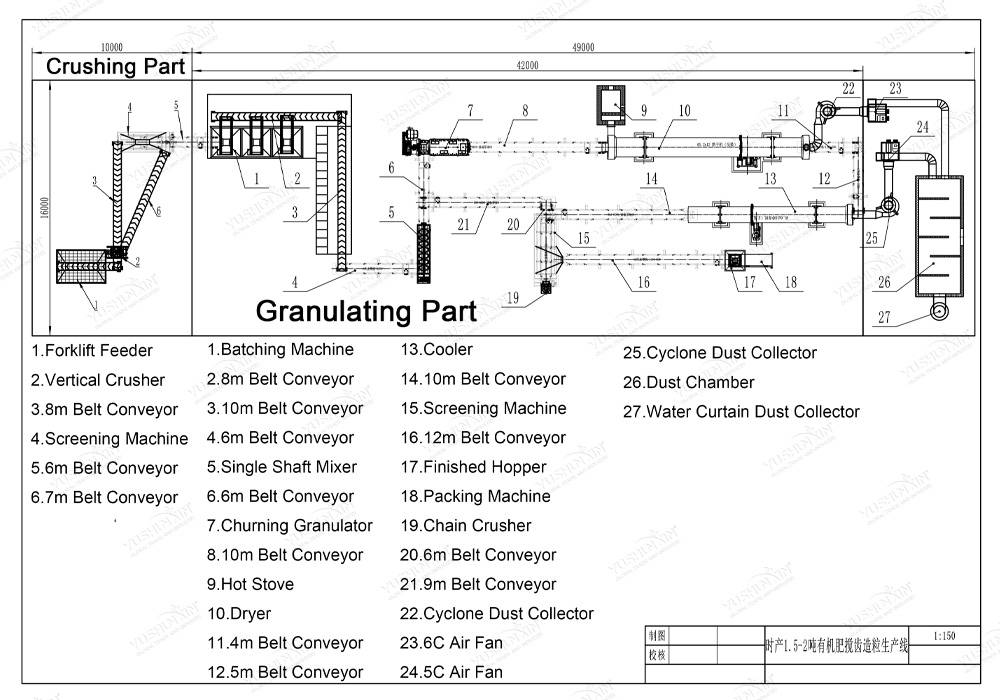







Для перетворення фосфату в придатну для використання форму добрива, потрібна кислота “газований” скеля, який виділяє розчинні сполуки фосфору. Загальні використовувані кислоти включають:
Щоб створити NPK добрива, інші джерела азоту та калію можна змішувати з фосфатним матеріалом. Деякі приклади включають:
Вартість кожної виробничої лінії змінюється залежно від виробничих потужностей, ступінь автоматизації, та конкретні потреби. Заповніть форму нижче, і ми надамо вам точну цитату!
Якщо вас цікавить наше обладнання для виготовлення добрив, Будь ласка, надішліть свої вимоги та контакти, і тоді ми зв’яжемось з вами через два дні. Ми обіцяємо, що вся ваша інформація не просочиться ні до кого.
- Компанія була заснована в 2005 і зосереджується на дослідженні та розробці та виготовленні органічного обладнання для добрив 20 роки. Він побудував 40 000 м мас-масштабне органічне обладнання для виробництва виробництва, Використання розширеної грануляції, Технології сушіння та скринінгу для підвищення ефективності виробництва та якості продукції.
- Самооперативне імпорт та експортне підприємство з більш ніж ніж 80 Професійні інженери по всьому світу, служити більше ніж 100 Країни та регіони по всьому світу, 5,000+ Справи з обслуговування клієнтів, 10 Центри обробки, 3 Лазерні різання машини, і більше ніж 60 обладнання різних типів.
- Підтримка довгострокової та широкої співпраці з багатьма науково-дослідними інститутами та університетами, with a professional R&D team, він може постійно оптимізувати продуктивність обладнання відповідно до попиту на ринку.
- Високостійкі матеріали, Вибір вуглецевої сталі Q235/сплав, щоб забезпечити міцне обладнання та зменшити витрати на обслуговування.
- Прийняття інтелектуальних систем управління для покращення рівня автоматизації виробництва та зменшення ручної залежності.
- ISO, CE, Міжнародна сертифікація SGS
- З масштабною виробничою потужністю, Він може відповідати різним вимогам до виробничих потужностей (невеликий, середні та великі виробничі лінії).
- Повний асортимент моделей обладнання, підходить для виробництва різних видів добрив, таких як органічні добрива, складові добрива, біологічне добриво, водорозчинні добрива, Рідке добриво, тощо.
- Персоналізований дизайн може бути наданий відповідно до потреб клієнта, включаючи виробничі потужності, Макет сайту, стандарти охорони навколишнього середовища, тощо.
- Надайте повний набір рішень для виробничих ліній, включаючи вибір обладнання, Встановлення та введення в експлуатацію, Технічна підготовка, тощо.

- Пряма заводська постачання, Зменшення посилання посередника, І ціна є більш конкурентоспроможною.
- Обладнання має високу енергоефективність, зменшує споживання енергії, і допомагає клієнтам зменшити довгострокові експлуатаційні витрати.
- Пряма заводська постачання, Зменшення посилання посередника, І ціна є більш конкурентоспроможною.
- Обладнання має високу енергоефективність, зменшує споживання енергії, і допомагає клієнтам зменшити довгострокові експлуатаційні витрати.
Постачання машини для полірування добрив провідному виробнику добрив у Нідерландах
Успішна поставка двовалкових грануляторів 1T/H клієнтам у Туреччині та Великобританії
Філіппінському клієнту доставлено ефективне рішення для перетворення компосту
Успішна поставка дискового гранулятора чилійському клієнту для виробництва добрив
Підвищення ефективності пелетування для GoodEarth Group, Південна Африка